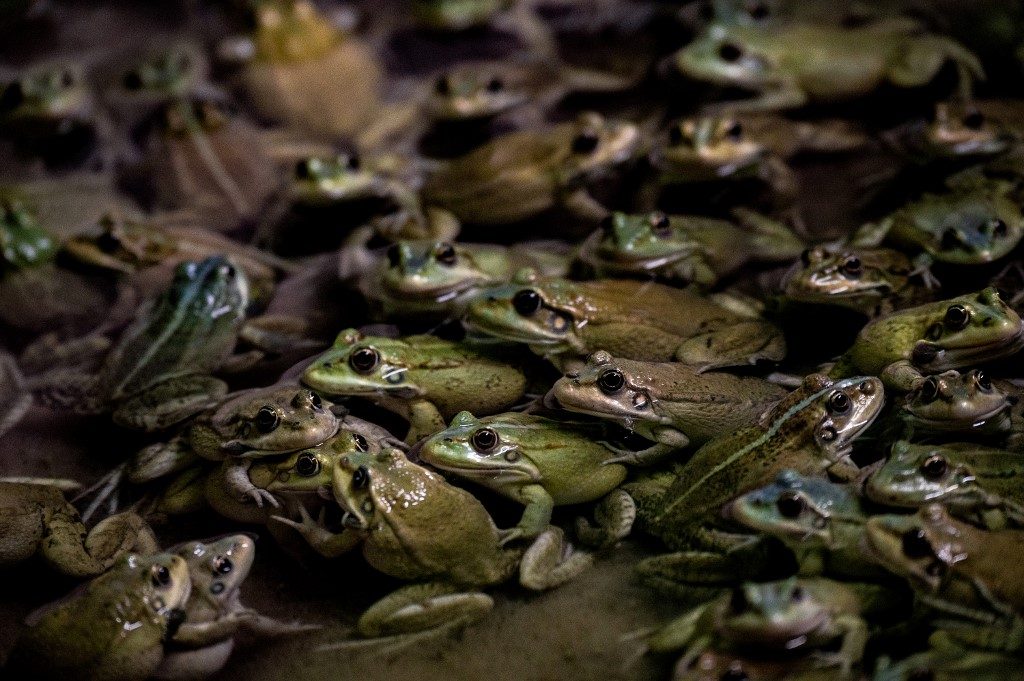SUMMARY
This is AI generated summarization, which may have errors. For context, always refer to the full article.

Every year, the French consume some 4,000 tons of frogs’ legs – the equivalent of 40 blue whales.
But nearly all the amphibian limbs that land on French plates come from abroad, since wild harvesting of the protected creatures is all but banned and their cultivation strictly controlled.
One of France’s handful of frog farmers, Patrice Francois, provides “cuisses de grenouille” to the kitchens of Michelin-starred restaurants and neighbourhood bistros alike.
Yet the 100,000 animals being raised at his greenhouses in Pierrelatte in southeast France hardly make a dent in demand for a delicacy that helped earn the French the nickname “frogs,” at least in the English-speaking world.
“Raising frogs is hard!” Francois told AFP amid a deafening chorus of croaks coming from dozens of ponds teeming with marsh frogs, his farm’s speciality.
“It is starting to work out, but I am not yet making a living from it,” said the 56-year-old, who started France’s first frog farm 10 years ago.
To make ends meet, he also runs a fishmonger’s in Roanne, around 230 kilometers (140 miles) north.
From the incubation of eggs through raising the tadpoles and fattening up the adults, it takes about a year to produce a frog weighing 50 to 100 grams (1.7-3.5 ounces), each yielding two hind legs much smaller than chicken thighs.
Finicky frogs
“We control the entire production chain, from breeding to slaughter after anaesthesia by cold, then butchery and shipping,” Francois said.
But there are many hurdles along the way.
For mating to happen, conditions have to be just right, with the weather and even the lunar cycle affecting the creatures’ amorous moods.
Each fertilization by a male frog of eggs deposited by a female can have a success rate of zero to 100%, depending on conditions, Francois said.
For a million eggs produced on the farm, some 100,000 or 10% eventually mature into frogs.
The animals are easily stressed, which is harmful to their health and growth, and can suffocate if too many are grouped together.
The frogs also have to be grouped by size to prevent the larger ones from cannibalizing smaller tank mates.
Extinction risk
Five farms in France produce about 10 tons of frog meat every year on average, according to the agriculture ministry, an amount that could reach 20 or even 50 tons as soon as this year.
Frogs have been eaten in France for centuries, particularly in the country’s east, but have been protected species since 2007 because of rapidly declining numbers.
Only small wild harvests for domestic consumption are allowed, with large fines for anyone trying to catch them for sale.
99% of frogs consumed in the country come from abroad – shipped alive or refrigerated mainly from Albania, Turkey, Bulgaria, Egypt, Belgium, and Italy, and in frozen form principally from Indonesia, Vietnam, and India, according to the French agriculture ministry.
Frogs are also eaten in other European countries such as Belgium, in the southern United States, and in parts of Asia.
Global consumption, according to a 2010 study, was 800 million to 3.2 billion frogs, with the US and European Union the largest importers, and Indonesia and China the main exporters.
Conservationists warn that many frog species are at risk of extinction, driven in large part by human appetites.
In key exporter Turkey, harvested species may be extinct by 2032, according to a study published this year by Cambridge University Press.
Michelin- starred
Among Francois’s top clients is the storied two-Michelin-star restaurant Bocuse, near Lyon in eastern France, which boasts frogs’ legs on its autumn menu.
Chef Gilles Reinhardt said the restaurant long had no choice but to rely on imports.
“But nothing beats these ultra-fresh French frogs. The clients love them!” he told AFP.
“The meat is much more delicate, the frogs fleshier and firmer… while still tender,” he said.
The restaurant gets 400 legs – or 200 pairs – twice weekly from Patrice Francois.
“We are selling them all, despite the context of COVID-19 and the dearth of foreign clients,” Reinhardt said. – Rappler.com
Add a comment
How does this make you feel?
There are no comments yet. Add your comment to start the conversation.